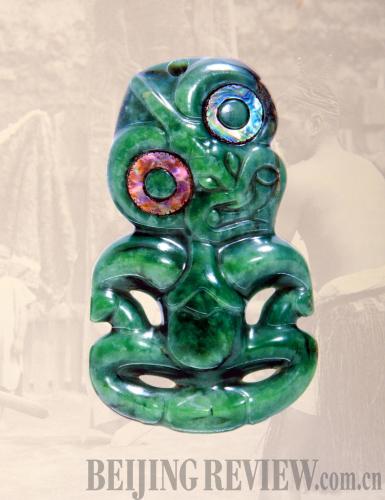|
 |
|
HEI TIKI: A pounamu (jade) neck ornament, the symbol of Te Ao Maori at the Shanghai Museum (OTAGO MUSEUM) |
An exhibition of Maori taonga (treasures) from New Zealand at the Shanghai Museum is exceeding expectations. In the first two weeks after opening on July 21, Te Ao Maori (The Maori Viewpoint) attracted approximately 55,000 visitors a week, well on track for its expected attendance of more than half a million before its closing date in early November.
Te Ao Maori, the first exhibition of Maori artifacts in a Chinese museum, is an introduction to the culture and mythology of the indigenous people of New Zealand. The exhibition, considered one of the most important overseas cultural displays in China this year, is drawn from the collections of the Otago Museum in Dunedin, Shanghai's sister city.
Te Ao Maori was made possible through the close working relationship between the Shanghai and Otago museums and their sister city bond. The show is being held in the Shanghai Museum's main Special Gallery.
Professor Chen Kelun, Deputy Director of the Shanghai Museum, said, "Dunedin and Shanghai have a long-standing sisterly relationship. Previous cultural exhibitions have contributed to the deep friendship between the Otago and Shanghai museums."
Te Ao Maori is a reciprocal exhibition for the Shanghai Museum's The Emperor's Dragons, held in the southern New Zealand port city in 2008, considered a major international show featuring highly prized Chinese treasures. The Otago exhibition in Shanghai this year has been on the drawing boards for some time with major progress made in the past three years.
"We believe the exhibition will be very popular with Chinese audiences, most of whom are not very familiar with Maori culture. Previously the New Zealand Pavilion at the Shanghai Expo in 2010 provided insight into the world of the Maori for the Chinese. This exhibition offers an even better opportunity to see the bigger picture," Chen said.
 |
|
WAHAIKA: A short club carved from whalebone with an ornate figure on one side of the blade (OTAGO MUSEUM) |
Intertwined cultures
"We hope our audience, via the exhibition, can get a hint of the similarities between the two cultures, as well as a greater understanding of the art, culture and history of New Zealand," Chen said.
Chen's thoughts were echoed by Li Zhong Mou, head of Shanghai Museum's Exhibition Department, who said, "There are possibly close cultural links between the Chinese and Maori, and greater numbers of scholars are becoming interested in the subject."
Research has shown the ancestors of the Maori came from Fujian Province and Taiwan, he said. This is evidenced by striking similarities between Taiwan's Hakka aboriginals and the Maori.
"You can find many commonalities between the Chinese and Maori, especially in jade. The Maori live so far away from China but their culture is like that of the Chinese," Li said.
Artifacts made of jade (pounamu) in Maori, may be the most familiar to Chinese audiences. The Maori and Chinese are among the few people in the world with such a high appreciation for greenstone, he said.
"We expect Chinese visitors will also be very interested because of anthropological research that indicates genetic similarities between the Maori and Chinese," Li said.
| 